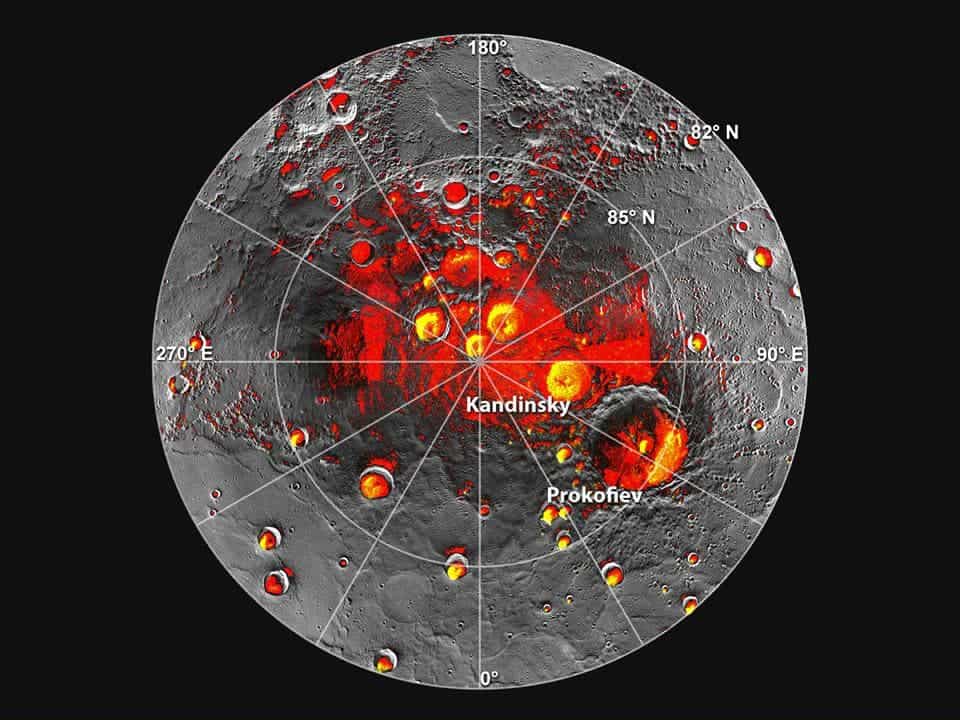The fist planet from the sun is the unlikeliest place you’d expect to find water ice, but new tantalizing evidence beamed back by the Messenger spacecraft orbiting Mercury suggests just so.

On the surface of Mercury, temperatures can reach boiling 752º Fahrenheit (400ºC), clearly water in any state can not exist. At its poles, however, things take a different turn. Since the planet’s axis tilt barely hits one degree, its poles are permanently shadowed from the sun’s rays – apparently, here temperatures range in the other extreme.
On a related note, it’s worth mentioning the contrary to intuitive thinking, Mercury isn’t the hottest planet in the solar system, despite being the first in line – the honor goes to Venus. Beauty triumphs again.
Ice on the first planet from the sun
Water ice has been hypothesized for decades to exist in Mercury’s poles. In 1991, Earth-based observations found that ice may be present after radar signals bounced back in a characteristic pattern. In 1999, the initial measurements were strengthened after astronomers used the more powerful Arecibo Observatory microwave beam in Puerto Rico. Later on, radar pictures beamed back to New Mexico’s Very Large Array showed white areas that researchers suspected was water ice.
Alas, nothing could be said for certain until closer observations could be made. The Messenger spacecraft launched in 2004, and after a series of flyby attempts it finally reached Mercury’s orbit on March 2011.
Now, the spacecraft has supplied three independent pieces of evidence from its high-precision instruments. The Neutron Spectrometer instrument on-board the spacecraft made first measurements of excess hydrogen at Mercury’s north pole, the Mercury Laser Altimeter (MLA) offered the first readings of reflectance of Mercury’s polar deposits at near-infrared wavelengths, while the same MLA compiled the first detailed models of the surface and near-surface temperatures of Mercury’s north polar regions that utilize the actual topography of Mercury’s surface.
“These reflectance anomalies are concentrated on poleward-facing slopes and are spatially collocated with areas of high radar backscatter postulated to be the result of near-surface water ice,” writes Gregory Neumann of the NASA Goddard Space Flight Center.
“Correlation of observed reflectance with modeled temperatures indicates that the optically bright regions are consistent with surface water ice.”
A monumental find
Moroever temperature gradients surprisingly suggested that dark, volatile materials are mixing in with ice. This is something consistent with climates in which organic matter survives. Neumann suggests that impacts of comets or volatile-rich asteroids could have provided both the dark and bright deposits, a finding corroborated in a third paper led by David Paige of the University of California, Los Angeles.
“This was very exciting. You are looking for bright stuff, and you see dark stuff – gee, it’s something new,” Neumann said.
Sean Solomon of the Columbia University’s Lamont-Doherty Earth Observatory, principal investigator of the MESSENGER mission stated:
“For more than 20 years the jury has been deliberating on whether the planet closest to the Sun hosts abundant water ice in its permanently shadowed polar regions. MESSENGER has now supplied a unanimous affirmative verdict.”
“But the new observations have also raised new questions,” adds Solomon. Do the dark materials in the polar deposits consist mostly of organic compounds? What kind of chemical reactions has that material experienced? Are there any regions on or within Mercury that might have both liquid water and organic compounds? Only with the continued exploration of Mercury can we hope to make progress on these new questions.”
In the one hour video conference below, Dwayne Brown from NASA’s office of communications, explains Messenger’s historic findings in broad detail.
The readings have only been made for Mercury’s north pole, but scientists are rather confident that water ice is present on its south pole as well. Messenger will spiral closer to the planet in 2014 and 2015, and more comprehensive measurements will then be available.
The findings were reported in the journal Science Express.
source: NASA






